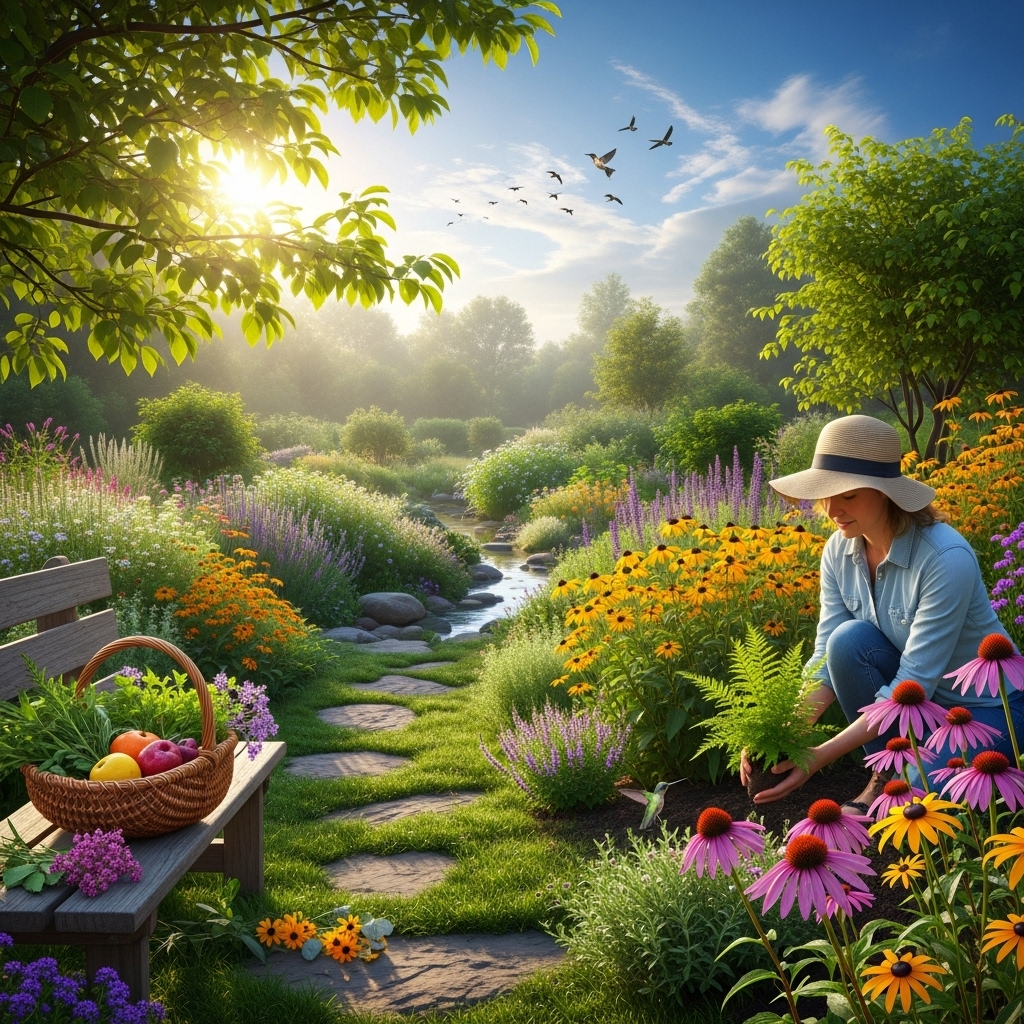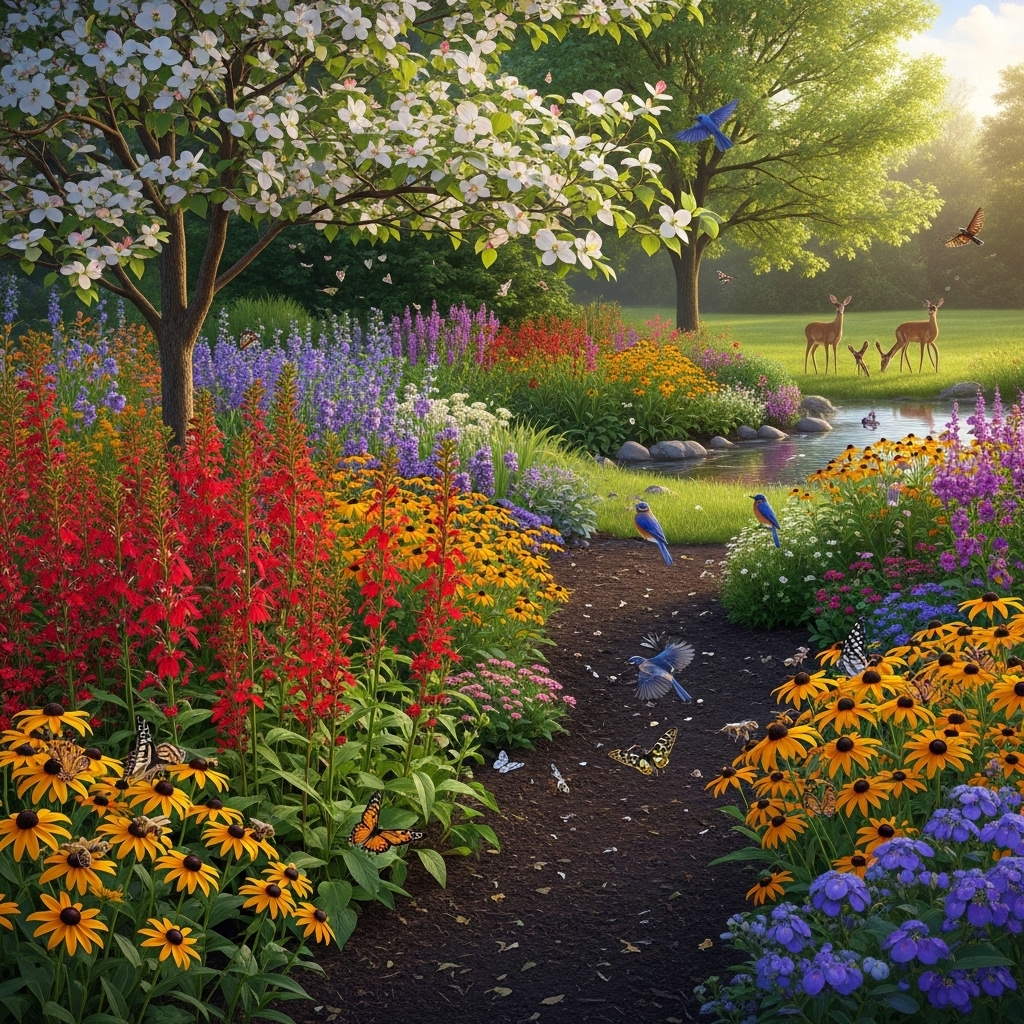Transforming my Virginia garden into a vibrant paradise has been a rewarding journey. By incorporating native species, I’ve not only enhanced its beauty but also supported local wildlife. Here are five native plants that can bring life and color to your garden.
Why Choose Native Plants?

When I first started my gardening adventure, I was overwhelmed by the sheer number of plant options available. However, I quickly discovered that choosing native species is not only beneficial for my garden but also for the local ecosystem. Native plants are those that naturally occur in a specific region, which means they are well-adapted to the local climate and soil conditions. This adaptability has made my gardening experience much more manageable.
Ecological Benefits
One of the most compelling reasons I opted for native plants is their ecological benefits. Native species provide essential habitat and food for local wildlife, including birds, butterflies, and bees. By planting these species, I’ve created a small sanctuary that supports biodiversity. For example, I’ve noticed an increase in the number of butterflies fluttering around my garden since I added native flowers, which serve as crucial nectar sources.
Low Maintenance
Another significant advantage I’ve enjoyed is the low maintenance that comes with native plants. Unlike non-native species, which often require extra care, such as frequent watering and fertilization, native plants thrive in Virginia’s natural conditions. They are generally more resistant to pests and diseases, which minimizes the need for chemical interventions. Since I started incorporating these plants, I’ve spent less time worrying about upkeep and more time enjoying my garden.
Water Conservation
Water conservation is increasingly important, and I found that native plants are often drought-tolerant. This means they require less water once established, which not only helps the environment but also lowers my water bill. I have been amazed at how resilient these plants are, even during dry spells. As a result, I can maintain a flourishing garden while being conscientious about water usage.
Five Native Species to Bring Your Virginia Garden to Life
Now that I’ve shared why I love native plants, let’s delve into five specific species that have truly transformed my garden. Each of these plants offers unique beauty and benefits, making them perfect additions to your own Virginia garden.
1. Eastern Redbud (Cercis canadensis)
The Eastern Redbud has become one of my favorite trees in the garden. This small, deciduous tree is adorned with stunning pink flowers in early spring that attract bees and other pollinators. Its heart-shaped leaves provide a lush canopy throughout the summer, and the beautiful fall color adds a splash of vibrant yellow and orange to my landscape. I love that it can thrive in various soil types and conditions, making it a versatile choice for any garden layout.
2. Black-eyed Susan (Rudbeckia hirta)
The cheerful yellow blooms of the Black-eyed Susan have brightened my garden throughout the summer months. This hardy perennial is easy to grow and thrives in full sun. The flowers attract butterflies, making my garden a lively spot for these beautiful creatures. I appreciate how they require minimal care and are drought-tolerant, making them a reliable choice for busy gardeners like me. The contrast of their dark centers against the golden petals creates a stunning visual that never fails to bring a smile to my face.
3. Virginia Bluebell (Mertensia virginica)
Virginia Bluebells are another treasure I discovered while exploring native plants. These delicate blue flowers bloom in early spring, creating a beautiful carpet of color in my garden. They thrive in moist, shaded areas, which has allowed me to fill in some of the shadier spots beneath my trees. Not only do they look stunning, but they also attract hummingbirds and other pollinators during their bloom period. Watching the bluebells sway in the breeze is a soothing experience that brings me joy each spring.
4. Butterfly Weed (Asclepias tuberosa)
As a passionate advocate for pollinators, I can’t recommend Butterfly Weed enough. This vibrant orange perennial is a magnet for butterflies, especially monarchs. I planted several patches across my garden, and I’ve been delighted to see these beautiful creatures stop by for a visit. In addition to attracting pollinators, this plant is drought-tolerant and thrives in well-drained soil, making it an ideal choice for sunny spots in my garden.
5. Wild Bergamot (Monarda fistulosa)
Lastly, I’ve found that Wild Bergamot, also known as bee balm, has become a delightful addition to my garden. The aromatic leaves and striking purple flowers not only add beauty but also attract a plethora of pollinators. I love the way the plant fills the air with its pleasant fragrance, especially during the warm summer months. Wild Bergamot is also known for its medicinal properties, and it can be a great conversation starter when I share its benefits with friends and family visiting my garden.
By incorporating these five native species into my Virginia garden, I’ve created a vibrant, sustainable, and low-maintenance landscape that supports local wildlife while providing me with endless enjoyment. In the next section, I’ll explore ways to further enhance your garden’s biodiversity and design elements that can complement these native plants.
Enhancing Biodiversity in Your Garden

After embracing native plants, I realized there’s even more I can do to foster biodiversity in my garden. Enhancing the ecosystem goes beyond just planting the right species; it also involves creating a habitat that supports a wide variety of creatures. I’ve found several strategies that have made a significant difference in attracting beneficial wildlife and increasing the overall health of my garden.
Creating Habitat Features
One of the first things I did was to incorporate various habitat features throughout my garden. I added a small water source, like a birdbath, which not only provides drinking and bathing opportunities for birds but also attracts other wildlife such as dragonflies. I love watching the birds splash around while sipping water, and it becomes a focal point of activity in my garden.
In addition to a water source, I’ve included different layers of vegetation. By planting tall flowers, shrubs, and trees, I’ve created vertical spaces that provide shelter and nesting sites for various animals. I noticed an increase in the number of birds visiting my garden since implementing this layered approach. I often hear their cheerful songs and see them flitting between branches, which adds to the garden’s liveliness.
Incorporating Mulch and Ground Cover
Ground cover plants have also played a crucial role in my garden’s biodiversity. I’ve introduced creeping thyme and other low-growing native species to help suppress weeds and retain moisture in the soil. This not only reduces my gardening workload but also creates a welcoming environment for insects and small critters. I’ve spotted various beneficial insects, such as ladybugs and bees, making their homes among the ground cover, which is essential for pollination and pest control in my garden.
Additionally, I’ve learned to appreciate the benefits of using natural mulch. I use shredded bark or straw around my plants, which helps maintain soil temperature and moisture while providing a habitat for beneficial organisms. The decomposition process enriches the soil, fostering a healthier ecosystem. Each spring, I notice how much more vibrant my plants appear, thanks to the nurturing environment I’ve created.
Planting for Continuous Bloom
To keep my garden teeming with life, I’ve focused on planting a variety of species that bloom at different times throughout the growing season. This approach ensures that there’s always something flowering, providing food sources for pollinators and other wildlife. For example, I’ve paired early bloomers like Virginia Bluebells with summer favorites like Black-eyed Susans, which helps maintain a steady flow of nectar and pollen availability.
By ensuring that my garden offers continuous blooms, I’m also able to attract a diverse array of pollinators. I’ve observed different species of butterflies, bees, and even hummingbirds visiting throughout the year. Each new visitor adds to the beauty and dynamics of my garden, making it feel alive and constantly evolving.
Incorporating Native Grasses
Another way I’ve enhanced my garden’s biodiversity is by incorporating native grasses. These plants not only provide texture and movement but also serve as habitats for various creatures. I’ve added species like Little Bluestem and Big Bluestem, which have become favorites for many birds seeking shelter. The grasses sway gracefully in the wind, creating a serene atmosphere while supporting essential wildlife.
Moreover, native grasses are excellent at preventing soil erosion and improving soil health. Their deep root systems help retain moisture and nutrients, which benefits the surrounding plants. I’m always amazed at how such simple additions can create a significant impact on the overall health of my garden. It has become a harmonious ecosystem where everything works together in a balanced way.
Engaging in Sustainable Practices
As I continue my gardening journey, embracing sustainable practices has become a priority for me. I’ve been mindful of how my actions affect the environment, and I’ve adopted various methods to ensure my garden remains eco-friendly. For instance, I use organic fertilizers and compost made from kitchen scraps, which not only nourishes my plants but also reduces waste.
I’ve also made an effort to reduce my carbon footprint by using hand tools and minimizing lawn maintenance. This not only benefits the environment but also gives me a greater appreciation for the work involved in nurturing my garden. Every time I pull weeds or prune plants, I feel more connected to the land and its inhabitants.
As my garden continues to flourish, I find joy in knowing that I’m actively contributing to the health of my local ecosystem. It’s incredibly rewarding to see how the combination of native plants, habitat features, and sustainable practices has created a thriving sanctuary for both me and the wildlife that call it home.
Final Thoughts
Transforming my Virginia garden into a vibrant and sustainable space has been a fulfilling journey. By focusing on native plants and enhancing biodiversity through various strategies, I’ve created a flourishing ecosystem that supports local wildlife while providing me with joy and beauty. I encourage fellow gardeners to explore the wonders of native plants and sustainable practices, as the rewards are endless. Together, we can create gardens that nurture not only our souls but also the world around us.
